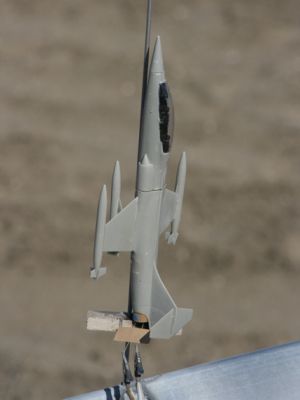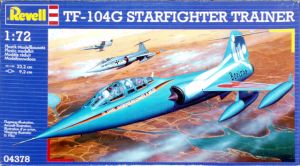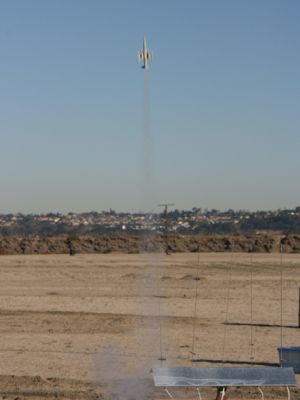
Brief:
This is a plastic model conversion from a Revell kit of the trainer version of the F-104 Starfighter. I originally
took on this project for the 2006 EMRR Challenge, but was unable to complete the kit in time. This is the first plastic
model that I've worked on in many years. Revell rated the original kit as a skill level 3 (out of 5) with the
description of "more demanding with up to 100 parts". The F-104 is a very stable design to start with so I
figured it would convert well to model rocketry.
Modifications:
I constructed the cockpit section as per the original instructions. Then I moved to the tail end of the model and was
pleasantly surprised to find that a BT-5 fit nearly perfectly in the 1/72 airframe opening. I joined the two halves
together and sanded the plastic until the motor tube fit easily. I lucked out again in figuring the seperation point of
the airframe. In the design of the original model, the front and back of the plane are divided slightly in front of the
wings. I left out the bulkhead that was supposed to go there so that the motor tube came through the rear half of the
plane. I shimmed the motor tube in place with bits of sprue that I trimmed from the trees and cemented it in place. I
epoxied an expended motor casing into the front half of the plane as a coupler and shock cord anchor. The model was
then completed per the original instructions.
One nifty little construction note: The afterburner/motor assembly that normally would have been glued in the tail of the plane, with minimal sanding, fits into the BT-5. It's a nice little display motor when I'm not flying the F-104!

Construction:
The Revell kit came with several sprue "trees" of little tiny plastic parts, including a clear one for the
canopy. The kit came with the option of building it with the gear up or down but up seemed the obvious choice since it
would be flying!
The quality of the plastic kit was typical. All of the parts were poly bagged in a cardboard box. Many of them however had broken off of their sprues which made identifying some of the little bits difficult.
The instructions were again typical for a plastic kit. Mostly illustrations of the little plastic bits with dotted lines to show where they should attach the numbered parts. Not great but adequate.
Construction and finishing of a plastic kit is a world apart from a paper and balsa rocket. Plastic model cement is a huge pain in the bottom to deal with! If you get it on any of the parts where it doesn't belong, it is not easily wiped off without damage to the part! Now I remember why I build rockets instead of plastic models!
Finishing:
I decided, instead of struggling through a paint and decal session with this model, I'd just fly it. The gray color
that the model was molded in isn't unattractive, so it's okay without paint.

Flight and Recovery:
I knew that I wanted to use a high initial thrust motor and as high an impulse as possible because of the extra
weight of the plastic. This left me pretty much one motor choice: the Estes A10-3T.
Prep for flight is minimal on this rocket. As there is practically no room in the motor tube for a chute, I decided to take my chances and let the model tumble recover. Luckily here in San Diego, our launch field is sand! I put a pinch of dog barf in to protect the elastic/Kevlar® shock cord that hand been installed with a paper mount to the side of the motor tube, masking tape fit the motor, and away we go!
After hearing many tales of past PMC flights, I called a "head's up" and punched the launch button. To my delight, the little plane leaped off the pad quite quickly and flew arrow straight into the sky! It ejected nearly perfectly and held together for the descent. The landing of the first flight broke one of the wings off. The second flight broke one of the wing pods off. The third flight almost hit my car on landing but suffered no damage!
Summary:
I had purchased the kit a few years ago for my NARTREK advanced project but hadn't gotten around to building it yet.
Obviously, I need to put a few more practice PMC kits together before considering putting out a competition quality PMC
for that!
While I found dealing with the adhesive frustrating beyond belief, I enjoyed putting the kit together and figuring out the challenge of making it flight worthy. Getting one to do so is the major pro of the process! I seem to have a durable, fun little flier on my hands.
The major con of any PMC these days is the availability and cost of a good plastic model kit. To get a kit above 1/72 or 1/48 scale can be quite costly, but without working at least these scales you can't fit a motor into it! With the inherent stability problems of many plastic kits, it's a risk to put a ton of cash and a whole lot of hours into constructing one of these rockets. They are designed to look cool sitting on a shelf, not soaring through the air.
 |
 |